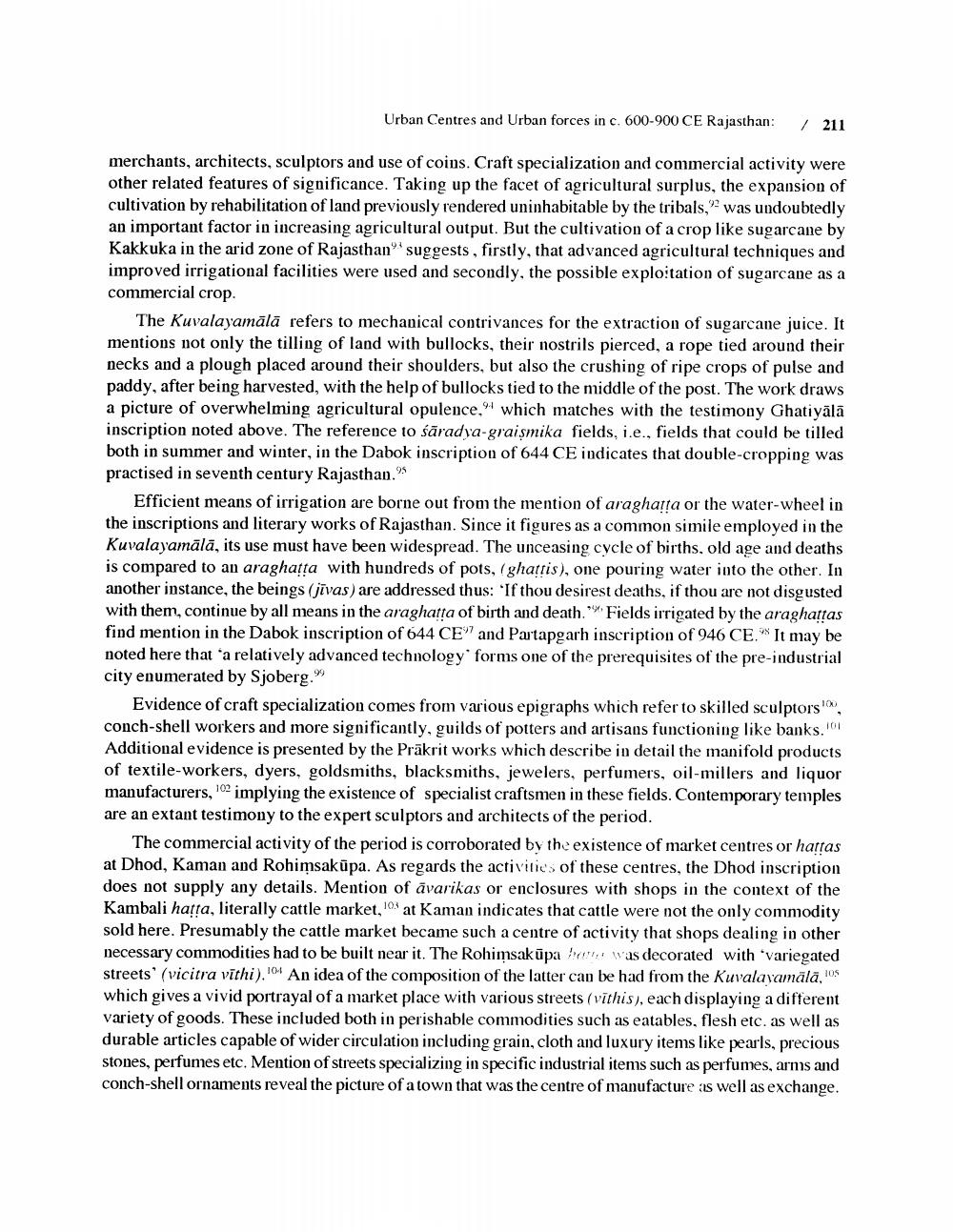________________
Urban Centres and Urban forces in c. 600-900 CE Rajasthan:
211
merchants, architects, sculptors and use of coins. Craft specialization and commercial activity were other related features of significance. Taking up the facet of agricultural surplus, the expansion of cultivation by rehabilitation of land previously rendered uninhabitable by the tribals, was undoubtedly an important factor in increasing agricultural output. But the cultivation of a crop like sugarcane by Kakkuka in the arid zone of Rajasthan” suggests, firstly, that advanced agricultural techniques and improved irrigational facilities were used and secondly, the possible exploitation of sugarcane as a commercial crop.
The Kuvalayamālā refers to mechanical contrivances for the extraction of sugarcane juice. It mentions not only the tilling of land with bullocks, their nostrils pierced, a rope tied around their necks and a plough placed around their shoulders, but also the crushing of ripe crops of pulse and paddy, after being harvested, with the help of bullocks tied to the middle of the post. The work draws a picture of overwhelming agricultural opulence, which matches with the testimony Ghatiyālā inscription noted above. The reference to śāradya-graişmika fields, i.e., fields that could be tilled both in summer and winter, in the Dabok inscription of 644 CE indicates that double-cropping was practised in seventh century Rajasthan.”
Efficient means of irrigation are borne out from the mention of araghatta or the water-wheel in the inscriptions and literary works of Rajasthan. Since it figures as a common simile employed in the Kuvalayamālā, its use must have been widespread. The unceasing cycle of births, old age and deaths is compared to an araghatta with hundreds of pots, ghartis), one pouring water into the other. In another instance, the beings (jīvas) are addressed thus: 'If thou desirest deaths, if thou are not disgusted with them, continue by all means in the araghatta of birth and death."Fields irrigated by the araghattas find mention in the Dabok inscription of 644 CE and Partapgarh inscription of 946 CE. It may be noted here that a relatively advanced technology forms one of the prerequisites of the pre-industrial city enumerated by Sjoberg."
Evidence of craft specialization comes from various epigraphs which refer to skilled sculptors' conch-shell workers and more significantly, guilds of potters and artisans functioning like banks. Additional evidence is presented by the Präkrit works which describe in detail the manifold products of textile-workers, dyers, goldsmiths, blacksmiths, jewelers, perfumers, oil-millers and liquor manufacturers, 12 implying the existence of specialist craftsmen in these fields. Contemporary temples are an extant testimony to the expert sculptors and architects of the period.
The commercial activity of the period is corroborated by the existence of market centres or hattas at Dhod, Kaman and Rohimsakūpa. As regards the activities of these centres, the Dhod inscription does not supply any details. Mention of āvarikas or enclosures with shops in the context of the Kambali hatta, literally cattle market, 10at Kaman indicates that cattle were not the only commodity sold here. Presumably the cattle market became such a centre of activity that shops dealing in other necessary commodities had to be built near it. The Rohimsakupa was decorated with variegated streets' (vicitra vithi). An idea of the composition of the latter can be had from the Kuvalayamālā, los which gives a vivid portrayal of a market place with various streets (vithis), each displaying a different variety of goods. These included both in perishable commodities such as eatables, flesh etc. as well as durable articles capable of wider circulation including grain, cloth and luxury items like pearls, precious stones, perfumes etc. Mention of streets specializing in specific industrial items such as perfumes, arms and conch-shell ornaments reveal the picture of a town that was the centre of manufacture as well as exchange.




